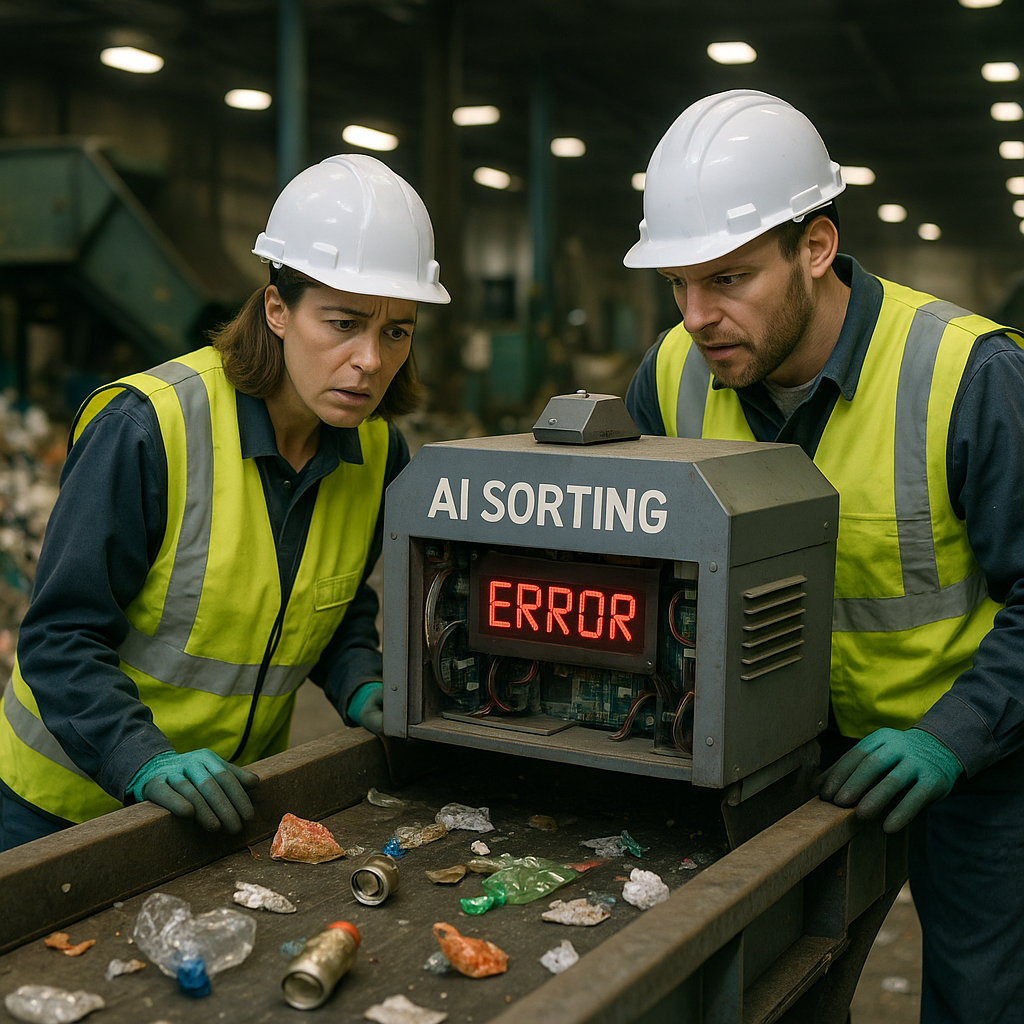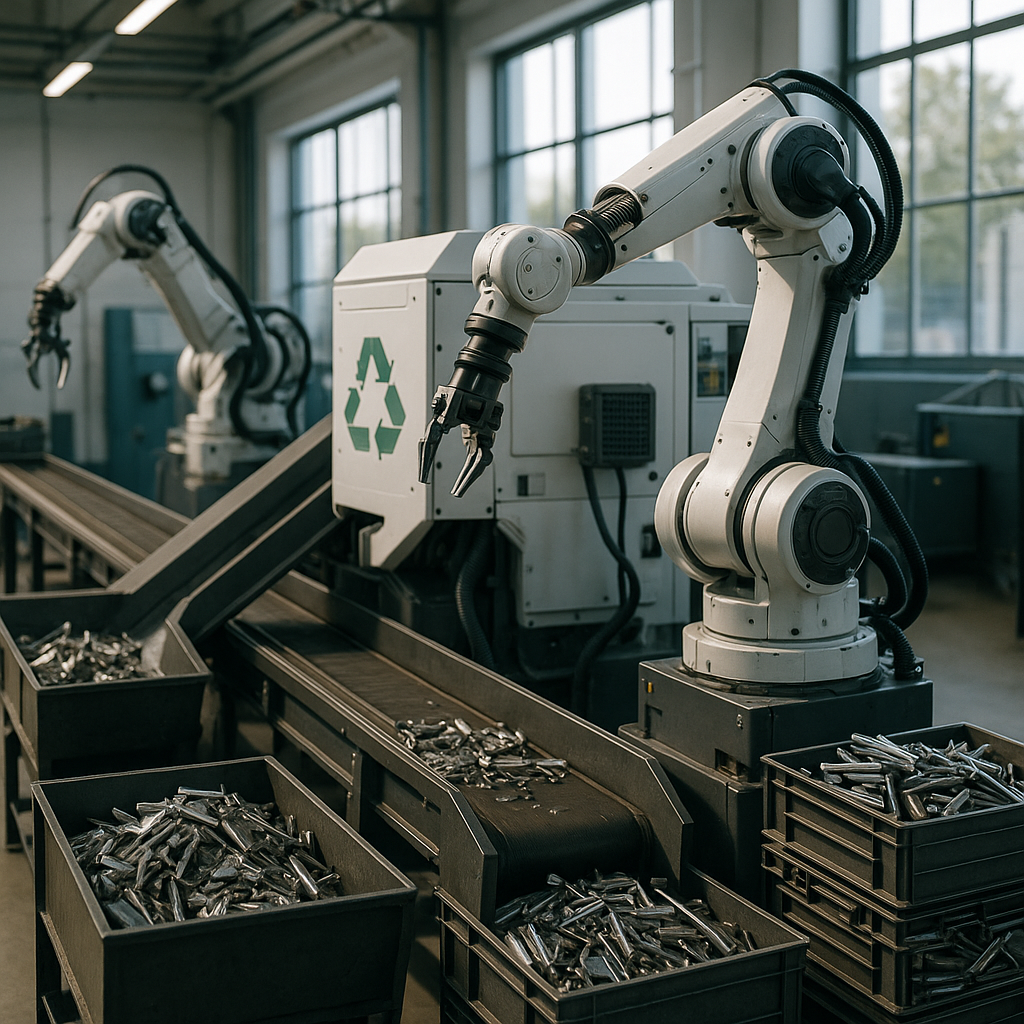5901 Botham Jean Blvd, Dallas, TX 75215
How is AI Transforming Metal Recycling Process Optimization?
November 4, 2025Traditional metal recycling operations encounter significant challenges that limit their effectiveness and profitability. Manual sorting processes are labor-intensive, prone to human error, and struggle with accurately classifying different metal alloys. These inefficiencies lead to material contamination, reduced recovery rates, and higher operational costs, impacting the bottom line for recycling facilities.
Artificial intelligence is transforming the metal recycling industry by advancing beyond traditional methods reliant on manual labor. For effective metal recycling process optimization, AI integrates technologies like machine learning and computer vision to enhance sorting accuracy, improve quality control, and streamline operations. Companies such as AMP Robotics have developed AI-based systems that identify and separate metals in recycling plants using computer vision and machine learning algorithms.
What are the key AI applications for optimizing recycling?
Automated Sorting and Material Identification
Computer vision systems are at the core of modern AI-powered recycling operations. These systems use high-resolution cameras and machine learning algorithms to identify and classify various metals and alloys based on their optical fingerprints. The technology analyzes surface properties, texture variations, and structural characteristics that human operators might miss during manual sorting processes.
Machine learning algorithms continuously enhance their accuracy by learning from thousands of material samples. Deep learning networks can differentiate between materials that look identical to the naked eye, such as aluminum foil versus aluminum cans, or different grades of stainless steel. This precision enables facilities to maintain contamination rates below 2% in many applications.
Robotic sorting systems combine these AI capabilities with mechanical precision. Modern AI-powered robotic arms can perform up to 120 picks per minute with 99% accuracy. These systems operate continuously without fatigue, processing materials at speeds that would require multiple human sorters to match.
Quality Control and Contamination Detection
Real-time monitoring systems employ AI algorithms to maintain consistent material quality throughout the recycling process. These systems detect impurities, measure material composition, and identify defects before they can compromise entire batches of recycled materials. Computer vision technology can spot contaminants like glass, wood, plastic, or personal items mixed within metal streams.
Predictive analytics tools analyze historical processing data to forecast potential quality issues before they arise. The technology identifies patterns in contamination sources, equipment performance degradation, and seasonal variations in material composition. This foresight enables operators to proactively adjust processing parameters instead of reacting to problems after they develop.
Contaminant detection systems use multiple sensor technologies in conjunction with AI decision-making algorithms. These systems can flag hazardous materials like batteries, aerosol containers, or ammunition that pose safety risks during processing. Early detection prevents equipment damage and reduces worker exposure to dangerous situations.
Process Optimization and Operational Efficiency
AI algorithms optimize workflows by analyzing material flow patterns, equipment utilization rates, and processing bottlenecks. Machine learning systems determine the most efficient routing of materials through sorting lines and recommend adjustments to maximize throughput. These optimizations often lead to 15-20% improvements in processing capacity without additional equipment investments.
Energy consumption reduction is a significant benefit of AI implementation. Smart systems monitor power usage across sorting equipment, conveyor systems, and processing machinery to identify inefficiencies. AI can automatically adjust operating parameters during peak and off-peak periods, reducing energy costs by up to 30% in some facilities.
Equipment performance monitoring leverages sensor networks combined with AI analytics to predict maintenance needs before failures occur. These systems track vibration patterns, temperature variations, and operational anomalies that indicate impending equipment problems. Preventive maintenance scheduling reduces unplanned downtime and significantly extends equipment lifespan.
Workflow automation goes beyond individual machines to coordinate entire facility operations. AI-driven analytics optimize efficiency with minimal human supervision, managing material intake, processing priorities, and output quality simultaneously. This systemic approach maximizes resource utilization while maintaining consistent product quality standards.
What are the challenges of implementing AI in recycling facilities?

Implementing AI technology in recycling facilities presents several significant obstacles that operators must navigate carefully. These integration challenges, while substantial, can be overcome through strategic planning and proper resource allocation.
System Integration and Technical Challenges
The most complex hurdle involves integrating AI systems with existing infrastructure. Many recycling facilities operate with legacy equipment that may not support advanced AI technologies. Integrating these systems requires substantial modifications to sorting lines and processing equipment.
Technical challenges extend beyond basic compatibility issues. AI systems struggle with identifying small items and maintaining consistent accuracy across different material types. Robotic arms have limited dexterity compared to human workers, leading to sorting misses and reduced efficiency in certain applications.
Continuous retraining requirements add another layer of complexity. AI models need regular updates to recognize new waste types and adapt to changing material streams. This ongoing technical maintenance demands consistent attention from facility operators.
Upfront Costs and Financial Barriers
The financial investment required for AI implementation creates a significant barrier for many facilities. Initial costs include purchasing smart sensors, robotic systems, backend software, and skilled personnel training. These expenses can easily reach hundreds of thousands of dollars for medium-scale operations.
Smaller municipalities and waste companies face particular challenges with these upfront costs. The investment requires substantial capital without immediate returns, making it difficult to justify the expense. Many facilities can only proceed with AI implementation through grant funding or program incentives.
Ongoing maintenance costs compound the financial challenge. Annual maintenance contracts can cost facilities upwards of $20,000, not including daily cleaning, software updates, and system repairs. These recurring expenses must be factored into long-term operational budgets.
Data Privacy and Security Concerns
AI systems in recycling facilities process large volumes of sensitive information, raising significant data security concerns. Current regulations around data privacy in waste management remain incomplete, creating uncertainty for facility operators.
The potential for data spillovers and prolonged data storage presents particular risks in electronic waste recycling. Facilities must ensure proper data destruction protocols while managing AI system requirements for historical data analysis.
Compliance with evolving privacy laws adds regulatory complexity. Facilities need transparent AI systems that can explain decision-making processes while maintaining data security standards. Balancing functionality and privacy protection requires careful system design.
Skill Requirements and Workforce Training
AI implementation demands a skilled workforce capable of operating and maintaining advanced systems. Most recycling facilities face shortages of qualified mechanics and technicians with AI expertise. This skills gap creates operational vulnerabilities when systems require troubleshooting or repairs.
Workforce training presents both immediate and ongoing challenges. Existing employees need comprehensive upskilling to work alongside AI systems effectively. Some workers may require retraining for new roles as AI takes over certain sorting functions.
The industry requires more specialized mechanics to meet maintenance requirements. Facilities often struggle to recruit and retain technical staff with the necessary skills to support AI operations. This staffing challenge can lead to extended downtime when systems malfunction.
Despite these challenges, successful AI implementation remains achievable through proper planning and strategic partnerships. Facilities that approach AI adoption with realistic timelines, adequate funding, and comprehensive training programs can overcome these obstacles and realize significant operational benefits.
What is the future of AI in the metal recycling industry?

The future of AI in metal recycling is heading towards an era of complete automation and connectivity. We’re moving toward fully autonomous recycling facilities where intelligent systems manage entire operations with minimal human intervention. These smart facilities will change how we process, sort, and track materials within the recycling ecosystem.
Autonomous Recycling Facilities
Autonomous recycling facilities represent the peak of AI advancement in our industry. These fully automated plants will incorporate AI-powered sorting robots, predictive maintenance systems, and real-time quality control. We expect these facilities to operate continuously, with self-learning algorithms improving efficiency and accuracy over time.
This transition to autonomous operations will significantly reduce labor costs while enhancing worker safety. Robotic systems will handle hazardous materials and repetitive tasks, reducing risks posed to human workers. This automation allows skilled personnel to focus on system optimization and strategic decision-making rather than manual tasks.
IoT Integration for Connected Operations
The Internet of Things is becoming the central nervous system of modern recycling operations. IoT sensors monitor equipment performance, track material flow, and optimize processing parameters in real-time. We can predict equipment failures before they occur and adjust operations based on incoming material compositions.
Smart sensors throughout our facilities provide unprecedented visibility into every aspect of the recycling process. These connected devices enable remote monitoring and control of sorting equipment and safety mechanisms, optimizing energy consumption and maximizing material recovery rates.
Future IoT implementations will extend beyond individual facilities, creating networks of recycling operations. This connectivity allows for coordinated material flows and shared processing capacity across multiple locations. We anticipate regional recycling networks that automatically balance workloads and optimize resource use.
Blockchain Technology for Supply Chain Transparency
Blockchain technology is enhancing material traceability in metal recycling operations. This distributed ledger system creates permanent records of each material’s journey from collection through processing. We can now provide customers with complete transparency about recycled materials’ origins and processing history.
Blockchain enables secure transactions and automated payments through smart contracts. When materials meet specified quality standards and reach designated processing milestones, payments trigger automatically. This reduces intermediaries and transaction costs while ensuring trust between all parties in the supply chain.
Global collaboration becomes possible as recycling facilities share blockchain-verified data about material availability and processing capacity. This transparency allows efficient resource allocation and helps stabilize commodity pricing. We expect blockchain adoption to grow as industry standards mature and regulatory frameworks develop.
Intelligent Ecosystems and the Circular Economy
The convergence of AI, IoT, and blockchain creates intelligent recycling ecosystems supporting true circular economy principles. These connected systems track materials throughout their entire lifecycle and optimize recovery strategies. We can identify the most valuable applications for recycled materials and route them accordingly.
Future trends point toward predictive analytics forecasting material availability and demand patterns. AI algorithms will analyze global supply chains, manufacturing schedules, and market conditions to optimize collection and processing strategies. This intelligence enables proactive decision-making rather than reactive responses to market changes.
The expansion of these technologies will make advanced recycling capabilities accessible to smaller operations and developing markets. As costs decrease and implementations become standardized, we expect rapid adoption across the industry. This democratization of technology will accelerate the transition to sustainable material management practices worldwide.
Conclusion: Embracing AI for a More Sustainable Industry

Artificial intelligence is fundamentally reshaping metal recycling by enhancing sorting accuracy, improving quality control, and optimizing processes. Although challenges like integration costs and skill requirements are present, the benefits of increased efficiency, cost savings, and higher-quality output are undeniable. Companies such as TOMRA and AMP Robotics demonstrate how AI-powered systems can achieve up to 95% recovery rates for materials like aluminum, while simultaneously reducing carbon emissions and operational expenses. These technological advancements represent more than just equipment upgrades; they are essential steps toward environmental conservation and sustainable recycling practices that benefit both industry stakeholders and communities.
Adopting AI technology is not simply a technical upgrade but a crucial step toward creating a more efficient, cost-effective, and sustainable recycling industry for a greener future. For organizations ready to implement these innovative solutions and contribute to environmental conservation, contact Okon Recycling at 214-717-4083 for comprehensive recycling services that combine cutting-edge technology with proven sustainability practices.
